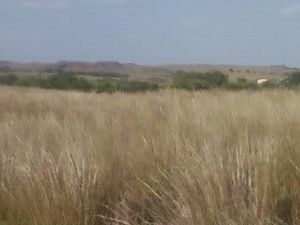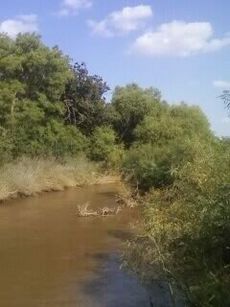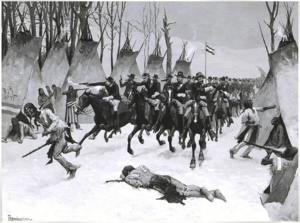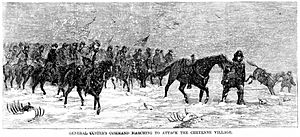Battle of Washita River facts for kids
Quick facts for kids Battle of Washita River |
|||||||
|---|---|---|---|---|---|---|---|
| Part of the Indian Wars | |||||||
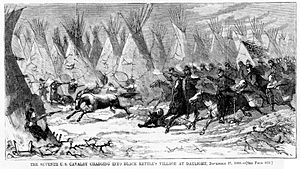 Battle of Washita from Harper's Weekly, December 19, 1868 |
|||||||
|
|||||||
| Belligerents | |||||||
| Cheyenne | |||||||
| Commanders and leaders | |||||||
|
|
Black Kettle † | ||||||
| Strength | |||||||
| 574 soldiers | 150 warriors (est.); total camp population 250 (est.) | ||||||
| Casualties and losses | |||||||
| 21 killed and 13 wounded | Range of military and civilian scout estimates: * 16 to 140+ men killed * "some" to 75 women and children killed Range of Cheyenne estimates: * 11 to 18 men killed * 17 to "many" women and children killed Total: *Estimates range from 13 to 150 total killed; 53 women and children captured See discussion below for further information and sources. |
||||||
The Battle of Washita River happened on November 27, 1868. It was a surprise attack by Lt. Col. George Armstrong Custer and his 7th U.S. Cavalry on a Southern Cheyenne village. This village was led by Chief Black Kettle and was located on the Washita River in what is now Oklahoma.
Black Kettle's camp was one of many Native American villages along the river. Custer's soldiers attacked it after tracking a group of Native Americans who had raided white settlements. Black Kettle and his people had been trying to live peacefully. During the attack, soldiers killed women and children, as well as warriors. They also took many people captive. The exact number of Cheyenne killed is still debated today.
Contents
Why the Battle Happened
The Medicine Lodge Treaty
After the Southern Cheyenne and Arapaho tribes signed the Medicine Lodge Treaty, they were supposed to move to a new reservation. This new land was in Indian Territory (modern Oklahoma). However, the tribes believed the treaty allowed them to keep their traditional hunting lands. These lands were important for hunting buffalo, which was a main food source and part of their culture. The new reservation had little good land and few buffalo.
Raids and Tensions
In the summer of 1868, some Cheyenne and allied warriors attacked white settlements. These attacks happened in Kansas, Colorado, and Texas. They killed settlers, wounded others, and took some people captive.
On August 19, 1868, an Indian Agent named Colonel Edward W. Wynkoop spoke with Little Rock, a chief in Black Kettle's village. Little Rock explained that a group of about 200 Cheyenne warriors had raided settlements. He agreed to try and bring those responsible to the authorities.
Native American Camps in November 1868
Winter Camps on the Washita River
By early November 1868, Black Kettle's camp joined other tribes on the Washita River. They called it Lodgepole River because of the many pine trees. Black Kettle's village was the westernmost of several winter camps. These camps stretched for ten to 15 miles along the river. They included Cheyenne, Arapaho, Kiowa, Comanche, and Kiowa-Apache bands.
Black Kettle's village had about 50 Cheyenne lodges. It also had a few lodges of visiting Arapaho and Lakota people. In total, about 250 people lived there. Other large camps were located downriver. These included Arapaho camps and more Cheyenne villages. Overall, about 6,000 Native Americans were camped along the upper Washita River.
Meeting at Fort Cobb
In mid-November, Black Kettle and other chiefs went to Fort Cobb. They wanted to talk with Colonel William Babcock Hazen about making peace. Black Kettle explained that his people wanted peace. He asked if they could move closer to Fort Cobb to avoid fighting.
Hazen told the chiefs he could not make peace with them. He explained that General Philip Sheridan was the "great war chief" in charge of fighting. Hazen said he could not control Sheridan's soldiers. He advised them to go back to their land and make peace with Sheridan. Hazen worried that if he made peace, more tribes might come to Fort Cobb. This could lead to another attack like the Sand Creek massacre of 1864.
Black Kettle's Return
Black Kettle and the other chiefs left Fort Cobb around November 21. They traveled through a storm and reached their villages on the Washita on November 26.
The night before, a group of about 150 warriors had returned to the camps. They had raided white settlements. On November 26, a Kiowa party also passed through Black Kettle's camp. They warned the Cheyenne that they had seen a large trail of soldiers. The Cheyenne did not believe soldiers would be so far south in such cold weather.
That evening, Black Kettle held a council meeting. They discussed Sheridan's war plans. They decided to send messengers to the soldiers after the snow cleared. They wanted to explain that Black Kettle's people wanted peace. They also planned to move their camp closer to the other villages the next day.
Some people in the camp were worried. Black Kettle's wife, Medicine Woman, was angry they were not moving right away. She felt they should have left earlier. White Shield, Black Hawk's brother, had a vision of wolves being scattered and killed. He tried to convince Black Kettle to move immediately, but he was not successful.
Sheridan's Winter Campaign
General Philip Sheridan was in charge of the U.S. Army's Department of the Missouri. He decided to launch a winter campaign against the Cheyenne. A winter campaign was difficult, but it was a good time to attack. Plains Indians were less mobile in winter. If their homes, food, and animals were destroyed, they would be forced to surrender.
Sheridan planned for three groups of soldiers to meet near the Texas Panhandle. Lt. Col. George Armstrong Custer led the 7th Cavalry, with 800 soldiers. They left on November 23, 1868, in heavy snow, heading south.
Custer's Attack
On November 26, 1868, Custer's Osage scouts found the trail of a Native American war party. Custer's troops followed this trail all day and night. They reached Black Kettle's village and Custer divided his soldiers into four groups. At daybreak, they attacked the village from different directions. Double Wolf fired his gun to warn the village, but he was one of the first to die. The cavalry musicians played "Garryowen" as a signal. Cheyenne warriors quickly left their lodges to find cover. Custer's forces soon took control of the village.
The Osage scouts were enemies of the Cheyenne. They led Custer to the village. They did not join the first attack because they feared soldiers might mistake them for Cheyenne. After the village was taken, the Osage entered. They helped the soldiers gather fleeing Cheyenne women and children.
Black Kettle and his wife, Medicine Woman, were killed while trying to escape on a pony. After capturing the village, Custer realized he was in danger. He saw large groups of Native Americans gathering on nearby hills. He learned that Black Kettle's village was just one of many camps along the river. Thousands of Native Americans were gathered there.
Fearing an attack, Custer ordered his men to take defensive positions. They seized the Native Americans' belongings and horses. They destroyed what they could not carry. About 675 ponies and horses were killed. They kept 200 horses to carry prisoners.
As night fell, Custer began marching his forces toward the other camps. The surrounding Native Americans retreated. Custer then turned around and returned to his supply train.
Custer reported that 103 warriors were killed. However, no actual count was made. Cheyenne and other Native American estimates are much lower. The 7th Cavalry had 21 soldiers killed and 13 wounded. Major Joel Elliott and 20 of his men were killed. Elliott had separated from his group while chasing fleeing Cheyenne. His small group was overwhelmed by warriors from other villages who came to help Black Kettle's camp.
Custer's quick withdrawal without finding Elliott and his men caused anger among his fellow soldiers. Many in the 7th Cavalry never forgave Custer for leaving Elliott behind.
Captives and Strategy
Custer's plan at the Washita River involved capturing Native American non-fighters. These included women, children, and the elderly. He used them to help his soldiers escape. When Custer's troops marched away, they placed the captured women and children among them. This made it harder for Cheyenne warriors from nearby villages to attack. The warriors were afraid of hitting the prisoners.
General Philip Sheridan had ordered his troops to "destroy [Indian] villages and ponies." He also ordered them to "kill or hang all warriors, and to bring back all woman and children [survivors]." This "total war" strategy aimed to make everyone in the Native American society feel the effects of war.
Benjamin "Ben" Clark, a scout with the Seventh Cavalry, said that women and children were killed during the attack. He reported that soldiers fired "indiscriminately" and killed "men and women alike." One unit was seen chasing and shooting at "a group of women and children." Clark estimated that 75 warriors and as many women and children were killed. Wounded warriors were also shot. This attack led to the complete destruction of Black Kettle's village.
Colonel Ranald S. Mackenzie used similar tactics in 1872. He attacked a Comanche village and captured 130 women and children. These captives were used to help his troops withdraw safely. They also served as a way to force the Native Americans back to their reservations and to free white captives.
In Popular Culture
The Battle of Washita River has been shown in many films and TV shows. These often reflect how people's views of Native American history have changed.
- The 1970 film Little Big Man showed the attack as a massacre.
- The 1991 TV film Son of the Morning Star showed the battle from different viewpoints. It showed Chief Black Kettle being killed by Custer's soldiers.
- The 2005 TV miniseries Into the West also showed Custer attacking Black Kettle's village.
- The TV series Dr. Quinn, Medicine Woman had a special episode called "Washita" in 1995. It showed Custer misleading settlers and Dr. Quinn trying to warn Black Kettle.
- In the 2003 film The Last Samurai, the main character, Captain Nathan Algren, is haunted by his part in the Washita action.
- The TV show Rawhide featured a colonel who was mentally affected by his role at Washita.
Images for kids
-
Battle of Washita from Harper's Weekly, December 19, 1868
-
Cheyenne captives, taken at Fort Dodge, Kansas en route to the stockade at Fort Hays; to the left stands U.S. Army chief of scouts John O. Austin.


